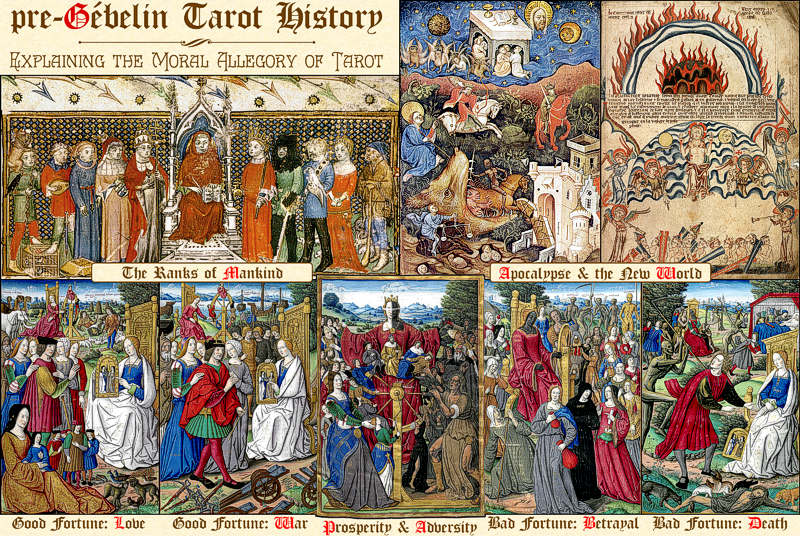Last Sunday's post discussed the three regional traditions of trump ordering. An interesting exception exists in the modern Piedmontese Tarot. No early decks from this region have survived, and the numbering of later decks is inconsistent with the ranking observed in play. These later decks have trumps which are double-headed in the most simplistic manner, using the top half of the trump pictures. Despite these mutilated images, they are obviously derived from the Tarot de Marseille design. Andrea Pollett describes the crude result:
This is the only tarot with such feature, apparently insignificant, though causing a complete loss of the details in the lower half of the illustrations; for instance, we can no longer tell whether the Fool is still bitten by a dog, nor how many personages turn around the Wheel of Fortune, nor whether Death is reaping lives with its blade, and so on. The Tower features no human figures (which should have been by its base), in the Moon the lake with a lobster in its center remains unseen, and in the World only the two upper symbols of the Tetramorph, the angel and the bull, are still visible, though repeated on both ends of the card.
REGIONAL TAROTS - 2: Milan - Piedmont
http://l-pollett.tripod.com/cards65.htm
Not surprisingly, the numbering of the trumps also follows the Tarot de Marseille design. Oddly, however, the game play does not follow that numbered ranking. Michael Dummett explains the paradox.
Where does this second French standard pattern for Tarot packs come from? On the wrappers and the Ace of Coins in the Netherlandish pack an unexplained phrase is written, "Cartes de Suisse". So far as I know, there is no trace of this pattern having been used or produced in Switzerland. Does the numeral XXII on the Fool indicate the transformation of that card into the highest trump in the game played in Belgium, of which unfortunately we know nothing? if so, could that practice have been derived from a Swiss game? In any case, the pattern can only have been of Italian origin. It has certain affinities with the Bolognese pattern, but it cannot have come directly from there; plausible places of entry are Nice and Savoy, both formerly part of the Duchy of Savoy. It thus seems very likely that it der4ives from the former Piedmontese standard pattern for the Tarot pack. Unfortunately, we cannot corroborate this by comparing it with the Piedmonteese cards. We have no Piedmontese Tarot packs from before 1730, by which time the Piedmontese card-makers were producing packs in imitation of the imported Tarot de Marseille; undergoing certain modifications, including becoming double-headed, this evolved into the present-day Tarocco piemontese, the only 78-card Tarot pack now made in Italy.
Evidence from card play shows us that Tarot in Piedmont has been heavily influenced by Bolognese practice. Piedmont is the only area in which two of the original Tarot traditions -- that of Milan and that of Bologna -- have contributed to the method of play. Bologna is a long way from Piedmont: we must conclude that Tarot was first introduced to Piedmont by someone from Bologna, but has since been influenced by neighbouring Lombardy. Two features suggest a Bolognese origin for Piedmontese Tarot. A curious feature of all Piedmontese games is that the Angel, numbered 20 in the Tarocco piemontese, ranks higher than the World, numbered 21; the Angel has a high point-value, while the World does not. People do not say, "What fun it would be to make the 20 higher than the 21". They do say, "I don't care what the number is: everyone knows that the Angel is the highest card". Presumably in the original Piedmontese standard pattern, the trumps were unnumbered, as they were in Bologna until much later, and players ranked the Angel as the highest trump.
There is a yet more telling feature. John McLeod first discovered some players in the region of Asti who used a 54-card Tarocco piemontese, shortened in the same way as Austrian Tarot packs. They not only treated the Angel as the highest trump, but also treated the Pope, Emperor, Empress, and Popess as equal in rank, one of them played later to a trick beating one played earlier to it. This is otherwise a distinctively Bolognese practice. Since then, the same practice has been found to have been observed in games played in Annecy in the late XVIII century, and in others, of Piedmontese type, played as late as 1930 in Nice, ceded to France in 1860 like Savoy.
Michael Dummett, "A Brief Sketch of the history of Tarot Cards", The Sylvia Mann Lecture, 2004, reproduced in The Playing-card, April-June 2005.)
Perhaps the most interesting speculation about the early Piedmontese design is that it may have been the precursor of the Belgium pattern. Dummett suggests that this is very likely, based on indirect evidence and a process of elimination. Unfortunately, nothing is known about the game played with the Belgium decks and, as noted above, no surviving examples of the early Piedmontese decks exist.


